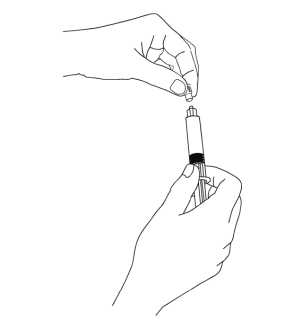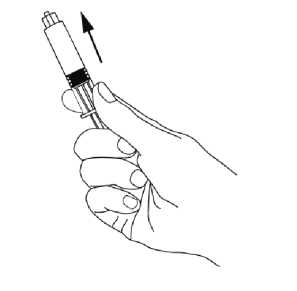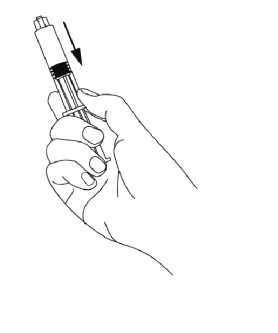Adenosine 3 Mg/Ml Solution For Injection In Pre-Filled Syringe
PACKAGE LEAFLET: INFORMATION FOR THE USER
Adenosine 3 mg/ml solution for injection in pre-filled syringe
Read all of this leaflet carefully before you start using this medicine because it contains important information for you.
- Keep this leaflet. You may need to read it again.
- If you have any further questions, ask your doctor or nurse.
- If you get any side effects, talk to your doctor or nurse. This includes any possible side effects not listed in this leaflet. See section 4.
What is in this leaflet
1. What Adenosine is and what it is used for
2. What you need to know before you use Adenosine
3. How to use Adenosine
4. Possible side effects
5. How to store Adenosine
6. Contents of the pack and other information
1. What Adenosine is and what it is used for
Adenosine contains a medicine called adenosine. This belongs to a group of medicines called 'antiarrhythmics'. Adenosine works by slowing down electrical impulses between the upper and lower chambers of the heart. This slows the fast or uneven heartbeats called 'arrhythmias'.
Adenosine is used in adults:
• During a test. This is to help doctors find out what type of arrhythmia (uneven heartbeat) you have
• To bring your heart beat back to normal if you have a type of arrhythmia called 'paroxysmal supraventricular tachycardia (SVT)' or 'Wolff-Parkinson-White Syndrome'.
2. What you need to know before you use Adenosine Do not use Adenosine if:
- you are allergic to adenosine or any of the other ingredients of this medicine (listed in section 6). Signs of an allergic reaction include: a rash, swallowing or breathing problems, swelling of your lips, face, throat or tongue
- you have problems with your heart rhythm and do not have a pacemaker (second or third degree atrioventricular block, sick sinus syndrome)
- you have very low blood pressure (severe hypotension)
- you have asthma or any other severe breathing problem
- you have a type of heart failure where your heart is not pumping out enough blood
- you have been told you have 'Long QT syndrome'. This is a rare heart problem that can lead to a fast heart beat and fainting
Do not have this medicine if any of the above applies to you. If you are not sure, talk to your doctor, nurse or pharmacist before you are given Adenosine.
Warnings and precautions
Talk to your doctor or nurse before using Adenosine if you have:
- low blood volume (hypovolaemia) which is not corrected by medicines
- narrowing of the left main artery supplying blood to your heart (left main coronary stenosis)
- been told that you have a heart problem whereby the electrical impulses in parts of your heart take longer than normal to discharge and then recharge (prolonged QT interval)
- narrowing of the main arteries in the neck (carotid artery). This means that not enough blood is getting to the brain (cerebrovascular insufficiency)
- heart disease due to narrowing of your heart valves (stenotic valvular heart disease)
- a left-right shunt in your heart. This will mean blood goes directly from the left side of your heart to the right side
- problems with a part of your nervous system called the 'autonomic nervous system'
- inflammation of the membrane surrounding your heart (pericarditis) or a build-up of fluid around your heart (pericardial effusion)
- had severe heart failure
- had a recent heart attack or if you have had a heart transplant in the last year
- any minor problem with your heart (first degree AtrioVentricular block or bundle branch block). These conditions may be temporarily aggravated when you are given adenosine.
- an unusual heart rhythm, for example your heartbeat is very fast or uneven (atrial fibrillation or atrial flutter) and in particular if you have a condition where your heart has abnormal electrical activity ('accessory conduction pathway')
- difficulty in breathing (bronchospasm)
- ever had fits or convulsions
If you get a very slow heartbeat (severe bradycardia), respiratory failure, a heart problem that can be fatal (asystole), severe chest pains (angina) or very low blood pressure (severe hypotension), then treatment with adenosine should be stopped.
If you are not sure if any of the above applies to you, talk to your doctor or nurse before being given Adenosine.
Other medicines and Adenosine
Tell your doctor or nurse if you are using, have recently used or might use any other medicines, including medicines obtained without a prescription.
This is because adenosine can affect the way some other medicines work. Also some medicines can affect the way adenosine works.
In particular, check with your doctor, nurse or pharmacist if you are taking any of the following:
• Dipyridamole (a medicine used to thin the blood). Make sure your doctor knows you are taking dipyridamole. Your doctor may decide you should not have Adenosine or may tell you to stop taking dipyridamole 24 hours before you are given Adenosine or may need to give you a lower dose of Adenosine
• Aminophylline or theophylline (medicines used to help breathing). Your doctor may tell you to stop taking it 24 hours before you are given Adenosine
• Caffeine (sometimes found in headache medicines)
Adenosine with food and drink
Food and drinks containing caffeine such as tea, coffee, chocolate and cola should be avoided for at least 12 hours before you are given Adenosine.
Pregnancy, breast-feeding and fertility
Talk to your doctor or nurse before having this medicine if:
• You are pregnant, might become pregnant, or think that you may be pregnant. You should not be given Adenosine if you are pregnant or think you may be pregnant, unless clearly necessary
• You are breast-feeding. You should not be given Adenosine if you are breast-feeding
If you are pregnant or breast-feeding, think you may be pregnant or are planning to have a baby, ask your doctor or pharmacist for advice before taking this medicine.
Adenosine contains sodium
Adenosine contains 3.54 mg sodium per ml (3.54 mg/ 1 ml pre-filled syringe, 7.08 mg/2 ml pre-filled syringe and 14.16 mg/4ml pre-filled syringe).
This should be taken into consideration by patients on a controlled sodium diet.
3. How to use Adenosine
How Adenosine is given
Adenosine is a medicine for use in hospitals
It will be given to you by a doctor or nurse as an injection
into your vein
Your heart and blood pressure will be closely monitored
How much Adenosine is given
If you are not sure why you are being given Adenosine or have any questions about how much Adenosine is being given to you, speak to your doctor, nurse or pharmacist.
Adults
• The first dose is 3mg given over 2 seconds. This is given by rapid injection into your vein
• If the first dose does not bring your heart beat to normal then you will be given a second dose. The second dose is 6 mg given as a rapid injection
• If the second dose does not bring your heart beat to normal then you will be given a third dose: The third dose is 12mg given as a rapid injection
• You should not have any more doses after the 12mg dose
Infants and Children
These pre-filled syringes are not suitable for administration of small volumes required for children.
Older people
See recommended dose for adults.
If you are given more Adenosine than you should
As this medicine is given to you by a doctor or nurse it is unlikely that you will be given too much. Your doctor will carefully work out how much Adenosine you should be given.
If you have more of this medicine than you should, the following effects may happen:
• Very low blood pressure (severe hypotension)
• Slow heartbeat (bradycardia)
• A heart problem (asystole)
Your doctor will be monitoring your heart throughout the procedure.
As the length of time adenosine stays in the blood is very short, any side effects of too much Adenosine would quickly stop when the injection is stopped. Sometimes you may need an injection of a medicine called aminophylline or theophylline to help with any side effects.
If you have any further questions on the use of this medicine, ask your doctor or nurse.
4. Possible side effects
Like all medicines, this medicine can cause side effects, although not everybody gets them.
While you are being given Adenosine you may have some of the following side effects.
If any of the following side effects get worse, tell your doctor or nurse and they may stop the injection:
The side effects normally settle within seconds or minutes after the injection is finished but you should tell your doctor or nurse if any of them happen.
Very common (may affect more than 1 in 10 people)
• Reddening of skin with a feeling of heat (flushing)
• Slow heartbeat (bradycardia)
• Skipped heart beats or extra heart beats
• A heart problem called an atrioventricular block where the heart starts to beat slowly
• Severe heart problems which can be fatal (asystole) or uneven heartbeat
• Shortness of breath or the urge to breathe deeply (dyspnoea)
• Chest pain or pressure on the chest
Common (may affect up to 1 in 10 people)
• Feeling dizzy or light-headed
• Feeling sick (nausea)
• Headache
• Unusual skin sensations such as burning
• Feeling nervous
Uncommon (may affect up to 1 in 100 people)
• Blurred vision
• Being aware of your heartbeat or feeling it 'racing' (palpitations)
• Metallic taste in your mouth
• Breathing more quickly or more deeply than normal (hyperventilation)
• Feeling pressure in your head, or weighed down feeling in your arms
• Feeling of general discomfort, weakness or pain
• Sweating
Very rare (may affect up to 1 in 10,000 people)
• Severe breathlessness or problems in breathing
• Redness, pain or swelling at the site of injection
• Feeling uncomfortable during the injection
• Worsening of high blood pressure that affects the brain (intracranial hypertension)
• Very slow, fast or uneven heartbeats
• Severe bradycardia (very slow heartbeat)
Not known (frequency cannot be estimated from the available data) loss of consciousness or fainting
• Fits (convulsions)
• Feeling sick (vomiting)
• Low blood pressure
• Your heart does not work properly to circulate blood around your body (cardiac arrest). This can be fatal.
• Your lungs do not work
• Stopping breathing (respiratory arrest)
• Allergic reaction (including rapid swelling and skin reactions such as urticaria and rash)
Reporting of side effects
If you get any side effects, talk to your doctor, pharmacist or nurse. This includes any possible side effects not listed in this leaflet. You can also report side effects directly;
For UK - Via the Yellow Card Scheme at:
For Ireland - Via;
HPRA Pharmacovigilance Earlsfort Terrace IRL - Dublin 2 Tel: +353 1 6764971 Fax: +353 1 6762517 Website: www.hpra.ie e-mail: medsafety@hpra.ie
By reporting side effects you can help provide more information on the safety of this medicine.
5. How to store Adenosine
This medicine will be kept by your doctor, nurse or pharmacist in a safe place where children cannot see or reach it.
Keep this medicine out of the sight and reach of children.
Do not use this medicine, after the expiry date which is stated on the carton. The expiry date refers to the last day of that month.
Adenosine should not be refrigerated.
The product is for single use only and should be used straight away after opening. Any portion of the pre-filled syringe not used at once should be disposed of.
Adenosine should not be used if your doctor or nurse notice any particles in the solution or any discolouration before they give you the medicine.
If the appearance of the medicine has changed, the prefilled syringe must be thrown away.
Do not throw away any medicines via wastewater or household waste. Your doctor and nurse will throw away medicines you no longer use. These measures will help protect the environment.

MOxxxxx/xx UK/IE V001
6. Contents of the pack and other information What Adenosine contains
• The active substance is adenosine. . Each 1 ml single dose pre-filled syringe contains 3 mg of adenosine. Each 2 ml single dose pre-filled syringe contains 6 mg of adenosine. Each 4 ml single dose pre-filled syringe contains 12 mg of adenosine. The other ingredients are: sodium chloride and water for injections.
What Adenosine looks like and contents of the pack
Adenosine is a clear, colourless solution for injection. Adenosine is supplied as packs containing 1, 6 or 10 prefilled syringes.
Not all pack sizes may be marketed.
Marketing Authorisation Holder and Manufacturer
Marketing Authorisation Holder Fresenius Kabi Limited Cestrian Court,
Eastgate Way,
Manor Park,
Runcorn,
Cheshire,
WA71NT UK
Manufacturer
Fresenius Kabi Austria GmbH Hafnerstrasse 36,
8055 Graz,
Austria
10 pre-filled syringes
5 ml plastic pre-filled syringe containing 2 ml (6 mg/2 ml) closed with a halobutyl tip cap
Packs containing:
1 pre-filled syringe
6 pre-filled syringes 10 pre-filled syringes
5 ml plastic pre-filled syringe containing 4 ml (12 mg/4 ml) closed with a halobutyl tip cap
Packs containing:
1 pre-filled syringe
6 pre-filled syringes 10 pre-filled syringes
Not all pack sizes may be marketed.
Special precautions for disposal
Do not use if any particles or discolouration are noticed in the solution.
Any unused medicinal product or waste material should be disposed of in accordance with local requirements.
Instructions for use of pre-filled syringe:
When using the 5 ml pre-filled syringe containing 4 ml (12 mg adenosine/4 ml) to administer only a 6 mg dose,
2 ml must be first discarded from the syringe before administering the remaining 2 ml to the patient.
This medicinal product is authorised in the Member States of the EEA under the following names:
Belgium
Denmark
Italy
Ireland
Netherlands
Norway
Poland
Portugal
Spain
Unithed
Kingdom
Adenosine Fresenius Kabi 3 mg/ml, oplossing voor injectie in een voorgevulde spuit Adenosin Fresenius Kabi Adenosina Kabi
Adenosine 3 mg/ml solution for injection in pre-filled syringe Adenosine Fresenius Kabi 3 mg/ml, oplossing voor injectie in een voorgevulde spuit
Adenosin Fresenius Kabi 3 mg/ml injeksjonsv^ske, oppl0sning i ferdigfylt spr0yte Adenosine Kabi Adenosina Kabi
Adenosina Kabi 3mg/ml solucion inyectable en jeringa
precargada
Adenosine 3 mg/ml solution for injection in pre-filled syringe
Use Aseptic Technique
1. Remove tip cap

This leaflet was last revised in July/2015
The following information is intended for healthcare professionals only:
Adenosine3 mg/ml solution for injection in pre-filled syringe
Please refer to the Summary of Product Characteristics (SmPC) for further details on this product.
Qualitative and quantitative composition
1 ml solution contains 3 mg of adenosine.
Each 1 ml single dose pre-filled syringe contains 3 mg of adenosine.
Each 2 ml single dose pre-filled syringe contains 6 mg of adenosine.
Each 4 ml single dose pre-filled syringe contains 12 mg of adenosine.
For the full list of excipients, see section 6.1.
Pharmaceutical form
Solution for injection in pre-filled syringe
Therapeutic indications
Rapid conversion to a normal sinus rhythm of paroxysmal supraventricular tachycardias, including those associated with accessory by-pass tracts (Wolff-Parkinson-White Syndrome).
Diagnostic Indications
Aid to diagnosis of broad or narrow complex supraventricular tachycardias. Although Adenosine will not convert atrial flutter, atrial fibrillation or ventricular tachycardia to sinus rhythm, the slowing of AV conduction helps diagnosis of atrial activity.
Sensitisation of intra-cavitary electrophysiological investigations.
Posology and method of administration
Adenosine is intended for hospital use only with monitoring and cardiorespiratory resuscitation equipment available for immediate use.
Adenosine should only be used when facilities exist for cardiac monitoring. Patients who develop high-level AV block at a particular dose should not be given further dosage increments.
Posology
Adult:
Initial dose: 3mg given as a rapid intravenous bolus (over
2 seconds).
Second dose: If the first dose does not result in elimination of the supraventricular tachycardia within 1 to 2 minutes, 6mg should be given also as a rapid intravenous bolus. Third dose: If the second dose does not result in elimination of the supraventricular tachycardia within 1 to 2 minutes. 12mg should be given also as a rapid intravenous bolus.
Additional or higher doses are not recommended.
Paediatric population
These pre-filled syringes are not suitable for paediatric use.
Elderly
See dosage recommendations for adults.
Diagnostic dose
The above ascending dosage schedule should be employed until sufficient diagnostic information has been obtained.
Method of administration: Adenosine should be administered by rapid intravenous (IV) bolus injection into a vein or into an IV line. If given into an IV line it should be injected through as proximally as possible, and followed by a rapid saline flush. If administered through a peripheral vein, a large bore cannula should be used.
Pharmaceutical particulars List of excipients
Sodium chloride Water for injections
Incompatibilities
In the absence of compatibility studies, this medicinal product must not be mixed with other medicinal products.
Shelf life
24 months.
The product should be used immediately after opening.
Special precautions for storage
Do not refrigerate.
Nature and contents of container
1 ml plastic pre-filled syringe containing 1 ml (3mg/1ml), closed with a halobutyl tip cap Packs containing:
1 pre-filled syringe 6 pre-filled syringes
2. Hold plunger and push barrel forward to relieve any resistance that may be present.

3. Pull the barrel down until air is expelled from the syringe.

